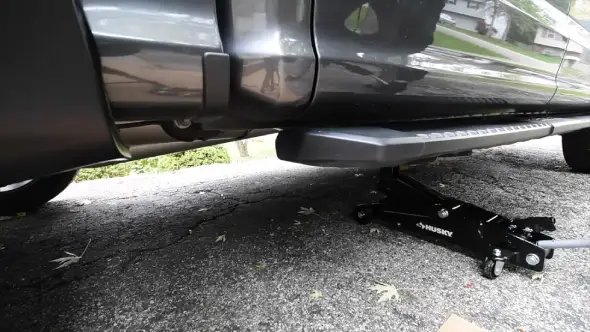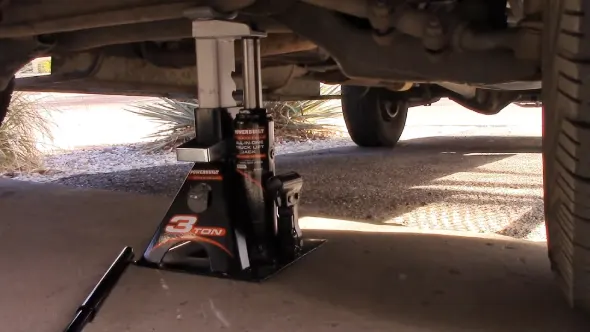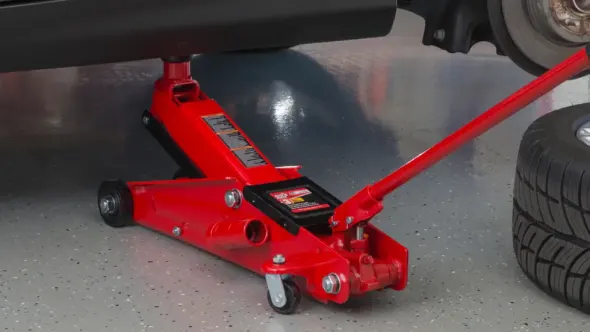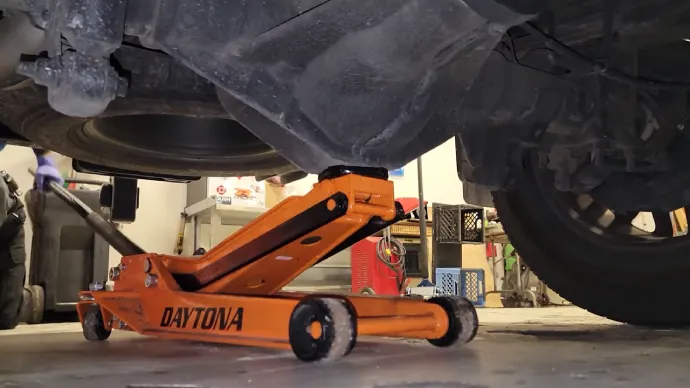Last Updated on April 17, 2023
Are you thinking of lifting your truck but not sure if your 3-ton floor jack is powerful enough? It’s a common concern regarding the maintenance of our vehicles. After all, everyone wants something reliable and safe that can handle the weight of our trucks.
So, will a 3-ton floor jack lift a truck? You can, but it depends on how much your truck weighs. Standard pickup trucks usually fall within the range of 2 to 3.5 tons (4,000-7,000 lbs) unloaded. But, if your vehicle falls into the higher end of that range or has any cargo onboard, then using just a 3-ton floor jack might be risky.
In these cases, it’s better to stick with a heavy-duty floor jack that can safely handle the weight of your car. Even though lifting a small truck with a 3-ton floor jack is possible, do your research beforehand. Find out more about this topic by reading on.
Will a 3 Ton Floor Jack Lift a Truck: How Many Lbs?

The most common type of 3-ton floor jack is a hydraulic floor jack, which can safely lift to 6,000 lbs or 2721 kg in weight, making them highly useful and versatile tools for automotive and industrial applications.
This is an excellent weight for any midsize pickup truck and SUV. It means you can easily lift industrial cars, lorries, and other trucks (such as Jeep Gladiator, Chevrolet Colorado/GMC Canyon, Toyota Tacoma, Ford Ranger, Nissan Frontier, and Honda Ridgeline FWD).
There are different kinds of floor jacks, so make sure you know what kind you need before you buy. Also, certain types of floor jacks may be better suited to specific vehicles or tasks than others.
Is a 3-Ton Floor Jack Best to Lift a Truck?
A 3-ton floor jack is often considered the best choice for lifting a light truck (weighs from 4,000-7,000 lbs) off the ground. It provides plenty of power and stability to handle even the heaviest loads. Many professional auto repair shops opt for at least a 3-ton floor jack due to its robustness and reliability.
The extra power of a 3-ton jack can be beneficial if you need to lift an axle, suspension, or large engine components. It will also provide enough power to tackle any job without constantly switching out jacks for different tasks.
Some people may question whether they need a 3-ton floor jack when they could get away with something smaller, like a 2.5-ton model. The truth is that heavier vehicles may require more power than the smaller models can, and a 3-ton model is often the safest choice in those cases.
A larger and heavier vehicle might require heavy load capacity jacks than what smaller jacks can offer, and going too small could result in damage or worse.
How to Lift a Midsize Truck with 3 Tons of Floor Jack?

Lifting a midsize truck can be intimidating if you don’t prepare properly. But if you follow these steps and take the necessary precautions, you can lift your truck safely and easily.
Step 1: Preparing the Jack and Vehicle
Before lifting your midsize truck with a three-ton floor jack, you must be aware of safety precautions and use the proper equipment. Make sure that all wheels of the truck are securely on level ground.
Place wheel chocks or leveling blocks around each wheel as an additional precaution for stability. Once you have secured the vehicle, locate your floor jack and assess it for damage or defects. Check if all parts fit together correctly, ensure no leaks, and the jack is recommended for vehicles up to 3 tons.
Step 2: Pumping the Jack
Once you have inspected the floor jack, find a place on the underside of your midsize truck where there is an area directly above one of the tires. Carefully place your floor jack in this spot and begin pumping the handle until it reaches a suitable height (about 6 inches to a maximum of 12 inches).
As you pump, it is important to avoid jerky movements when raising or lowering the jack so as not to damage yourself and your vehicle. Using an electric floor jack, keep your hands at least 12 inches away from any moving parts while pumping.
Step 3: Placing Support Stands
When lifting a midsize truck with a 3-ton floor jack, support stands or jack stands should also be used to ensure the full safety of both yourself and your vehicle.
Place your support stands on either side of the tire at an appropriate height. This should be higher than where you set up the jack but lower than what it takes to work comfortably beneath your truck without putting strain on either yourself or its frame.
Also, ensure sufficient room between any two points of contact between both objects (floor jack/support stands and truck) so as not to cause unnecessary stress when maneuvering around them during repair work or maintenance.
Step 4: Continuing Pumping
Continue pumping until your midsize truck has lifted the truck off its four wheels by approximately 6–8 inches (depending on personal comfort levels).
It may be useful to check in regularly while pumping and adjust accordingly as needed throughout. This process ensures that neither yourself nor any part of your vehicle’s frame becomes strained under sudden pressure differentials caused by miscalculation or misjudgment during execution.
When satisfied with the lift height reached by your floor jack, release pressure from its handle before continuing onwards towards the completion of repair or maintenance work beneath it safely.
Step 5: Finalizing Safety Precautions
Once all the repair/maintenance work has been completed on your midsize truck, check the floor jack and support stands for any wear or signs of fatigue. This will ensure they are safe for future scenarios involving similar fixings/adjustments on vehicles within this tonnage range.
What are the Safety Considerations When Using a 3-Ton Floor Jack to Lift a Truck?

Using a 3-ton floor trolley jack to lift your truck is a quick and easy way to take care of maintenance projects. But it also comes with numerous safety risks that you have to think about. Following these steps can help you stay safe while using your floor jack:
Understand the Basics:
Before using a 3 ton jack, you must familiarize yourself with its components and operation. Understand the flor jack’s weight capacity and ensure it is appropriately rated for your job.
Check to ensure that all parts are in good working condition, that all pins and screws are securely tightened, and that the jack is free from any damage or deformity.
Securely Position the Jack:
When positioning the jack under your vehicle, place it on solid ground and choose a spot where there will be enough clearance for operation.
When raising your vehicle on either side of the jack, ensure that you check for any obstructions between them, such as rocks, sticks, or other items which can cause an accident if not removed.
Also, it’s essential never to attempt to move a loaded 3 Ton floor hydraulic jack instead, use a separate dolly or other means of transportation if needed.
Properly Support Your Vehicle:
Never rely solely on a 3 Ton floor car jack for long-term support of your vehicle; rather use four steel supports, such as stands or blocks, to hold up your car while you work on it firmly.
Be sure to check the floor jack’s weight rating against that of your vehicle before attempting any repairs, and observe proper placement techniques by placing two supports at each end of the jack near its contact points with your vehicle’s frame or lower members.
Don’t Exceed Limits:
A 3-Ton floor jack isn’t designed to lift heavy loads like trucks or vans. Instead, they’re intended only for lighter jobs like raising vehicles high enough off the ground so you can work underneath them safely.
Therefore you must never try to exceed their weight limits as this could lead to serious accidents resulting in injury or death due to equipment failure caused by overload conditions.
Lift Evenly:
When lifting your vehicle, ensure that you do this evenly and smoothly on both sides rather than at one end, as this could cause an imbalance which could lead to an accident if not corrected quickly enough.
Inspect Regularly:
As with any tool, regular inspections should be conducted on your 3-Ton floor jack before each use to ensure its safe operation throughout its lifetime. Make sure all bolts are tight and look for signs of distress, like dents or cracks in both plastic and rubber parts, as these could weaken the structural integrity over time.
Additionally, inspect hydraulic fluid levels per manufacturer guidelines every few months to keep them adequately supplied throughout their lifespan so that you get optimal performance out of your equipment every time you use it.
Will a 3-Ton Floor Jack Lift a Ram 1500 Truck?

A 3-ton floor jack is usually suitable for most vehicles, including the Ram 1500 truck. Generally speaking, these jacks have a lifting capacity of up to 6,000 pounds and can easily handle the weight of most cars and trucks.
The Ram 1500 has an average curb weight of around 5,400 pounds, so it should be within the capacity of a 3-ton floor jack. When using any type of floor jack, ensure to read the manufacturer’s recommended guidelines and always use it following those recommendations for maximum safety.
Can You Lift More Weighted Trucks Than the 3-ton Floor Jack’s Capacity?
Using a 3-ton floor jack on heavy trucks can be risky and is generally not recommended by manufacturers. While you might be able to lift more than 6,000 pounds with this type of jack, doing so could damage your vehicle or cause injury due to the increased pressure on both the vehicle and the jack itself.
However, it is possible to use the jack to lift just one wheel of a much heavier truck with this capacity. This can be useful in certain situations, such as replacing tires or changing brake pads on the vehicle.
Easily Lift Medium-Sized Trucks With the Versatile 3-Ton Floor Jack
In the end, using a 3-Ton floor trolley jack is an effective way to lift any vehicle, from small cars to medium-sized trucks. But, important safety considerations must be taken before attempting any kind of vehicle lifting procedure.
It is always recommended that you read up on how best to use your 3 Ton floor jack and seek professional help before attempting a lift with this tool. With the right precautions in place, you can be sure that your vehicle will be lifted safely and securely with minimal risk involved.
